City Classics HO scale Main Street Cafe
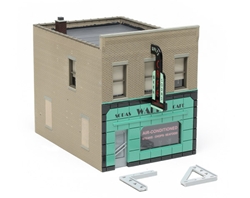 (90-degree corner braces sold separately) |
Reviewed in Model Railroader magazine
By Cody Grivno
Published: June 14, 2012
Price: $27.98
Manufacturer
City Classics
P.O. Box 16502
Pittsburgh, PA 15242
cityclassics.biz
Era: 1930s to present
Comments: Modernized brick buildings have been a part of main streets throughout the United States since the 1930s, and City Classics has captured that distinct look with its latest HO scale structure kit. The Main Street Cafe (kit no. 115) features injection-molded plastic walls, separate windows, doors, and wall coping, paper window signs, and water-slide decals. The building has a footprint of 3-1/8" x 4-1/4".
The kit has clear and well-illustrated instructions, making it easy to build. However, the manufacturer recommends that the builder have some prior modeling experience.
I assembled the back and side walls first. Because of the kit's design, the roof has to be inserted into the groove in these wall sections before the front wall is attached. I appreciated that the doors, windows, and wall coping were separate. This saved time as I didn't have to mask these parts.
This structure also gave me a chance to try City Classics' new 90-degree corner braces. The braces, which measure 1" x 1", help reinforce corner joints and keep them square. They work with all brands of kits can also be used to support roofs and floors. A 16-pack of braces (12 inside corners, 4 outside) sells for $6.98.
Though the structure comes with paper window blinds that can be attached to the PVC window material, I used the more colorful window treatments included with City Classics item no. 710, sold separately. The Venetian blinds and window shades are printed on clear acetate.
City Classics has done a great job capturing the Art Deco styling on this building. The Main Street Cafe is sure to give your downtown scene some unique flavor.
City Classics HO scale Carnegie Street Manufacturing Building Kit
A Model Railroader subscriber
by Brandon Eckhardt // Published: January 12, 2010
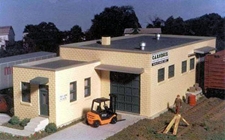
I have an empty siding on my shelf layout at home. Wanting to fill it with a manufacturing building of some sort I found one by City Classics. This particular kit is inexpensive but of good quality plastic.
On receiving it, the instructions are detailed, the model is unpainted which adds to the fun, and there are enough pieces to let you have the freedom to build this in a variety of ways. The instructions suggest some ways to build the model and if you are of a mind to kitbash, this model would be a good place to start. Simply put, there are pieces for one main building and pieces enough for two additions.
Paper signs are included which offer more flexibility as well so I don't have to print my own if I prefer not to. The kit also comes with two peices of sheet styrene (for flat roofs) and one piece of clear plastic for windows.
I picked this up through Walthers but found further information and a few pictures from the City Classics website. I highly recommend this kit for anyone who has space to fill on their railroad or would like to have an inexpensive yet good quality kit to try their hand at kitbashing.
The MSR is $18.98.
City Classics HO scale company house is a common design
Reviewed in the January 2004 issue
by David Popp // Published: March 25, 2004
�HO company house is a common design
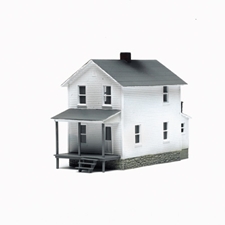 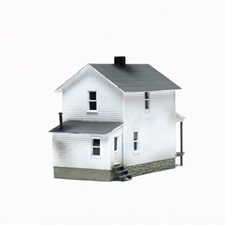 |
Here's a company house that'll fit perfectly on the gritty blue-collar side of the tracks on most model railroads. Made by City Classics, this easy styrene structure kit follows the form and function of numerous dwellings commonly found around industrial centers from the late 1800s to the present.
Small two-story frame houses such as these were constructed throughout North America beginning in the late 1800s. Often built and owned by large companies such as steel mills and mines to house their employees conveniently nearby, the style of dwelling quickly earned the nickname "company house." They were typically built in such quantities that they formed whole company towns.
The Spartan houses were constructed from standardized plans and provided only basic living necessities for the workers, usually lacking most comforts such as electricity and plumbing. Most have a living room across the front of the first floor with a small kitchen in back. The second floor was divided into several bedrooms.
After World War II, many corporations began selling their company houses to the occupants. These new owners often expanded the original dwellings through various additions like porches and back or side rooms. The most common upgrade was to provide indoor plumbing by enclosing the back porch. City Classics' kit is easy to build and comes with flat plastic parts and a few .060" square styrene strips for bracing corners. The wall sections are made of injection-molded white plastic and include nice window and door detail, as well as siding and a simulated fieldstone foundation. The styrene roof sections feature rolled tarpaper roofing. All parts were fairly clean of flash and fit together well with only minor adjustments. The kit can be assembled in less than an hour and includes parts for an optional covered front porch, an enclosed rear addition, steps, and an outhouse. It also includes a sheet of clear window glazing. The finished model, with the porch and rear addition, has an approximate 2¼" x 5" footprint.
The instruction sheet provides an exploded-view diagram of the structure, a very detailed set of instructions for assembling and painting the model, and a brief history of company houses. I assembled the kit with liquid styrene cement and finished it with Polly Scale paints. I started by painting the whole house with a base coat of Reefer White. Next I painted the porch and steps UP Harbor Mist Gray and the roof UP Dark Gray. I brushed a coat of Polly Scale Concrete on the stone foundation, then darkened the mortar lines with a wash of UP Dark Gray.
City Classics has produced a great kit. Because of its simple construction and nice molding detail, the company house looks good as is, or it can be easily kitbashed into other structures with a "family" appearance. Combining two kits into an L-shaped building could represent a more ambitious owner's one- or two-story addition. The model can also be cut down to create a single-story house. With the addition of a few detail parts and some extra styrene strips, you could easily customize a whole neighborhood of company houses to fill those residential streets near your railroad's main line.
�HO Company House�
�
Price: $18.98 each
$49.98 per three-pack
HO Scale Roadside Diner
Reviewed in Model Railroader magazine
August 1997 issue
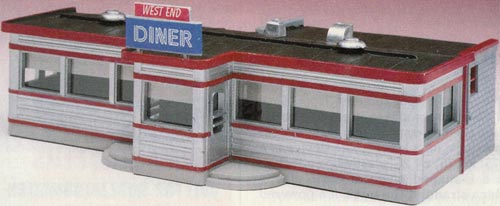
City Classics' latest kit is this neat roadside diner, as easy-to-assemble injection-molded styrene kit typical of prototype diners built in the 1940's. Prototype diners were usually made of stainless steel, and some of these classic restaurants continue to serve patrons in Eastern cities - especially in older neighborhoods near railroads.
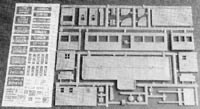 Most of the parts are molded in light gray styrene, including ten wall panels, a main roof, exhaust fans, signs and steps. Clear styrene is provided for window glazing and a small sheet or styrene is used for the kitchen' flat roof. A free-standing roadside sign and several add-on details are also supplied as separate pieces that can be added as desired.
Most of the parts are molded in light gray styrene, including ten wall panels, a main roof, exhaust fans, signs and steps. Clear styrene is provided for window glazing and a small sheet or styrene is used for the kitchen' flat roof. A free-standing roadside sign and several add-on details are also supplied as separate pieces that can be added as desired.
A nicely done illustrated instruction sheet contains step-by-step directions, as exploded isometric drawing, diagrams, and finishing hints.
Tool requirements are minimal. I used a pair of flush-cutting pliers, a sharp hobby knife, files, a paintbrush, and liquid plastic cement.
Building the kit is easy, but be sure to square the edges as explained in the instruction. I also smoothed the backs of the walls with a file to remove any molding marks wihich might interfere with window glazing later on. I built my diner in two assemblies to make painting easier.
Painting this model actually takes more time than building it. I began by spraying the main building with Testor's Chrome Silver spray paint. While it dried, I spray-painted the kitchen addition with Floquil SP Lettering Gray and set everything aside to dry. The next day I brush-painted the roof with Accu-Flex Weathered Black and highlighted the trim with Signal Red. The foundation and steps were also brush-painted, using Accu-Flex Concrete Gray.
Once the paint was dry, I added window glazing and some shades cut from a file folder to hide the empty interior.
 City Classics includes a nice selection of red-and-white or blue-and-white period signs on paper which may be cut out and glued in place. If you prefer decal lettering, Microscale recently released two suitable set (nos. 87-982 and 87-983) designed especially for this model.
City Classics includes a nice selection of red-and-white or blue-and-white period signs on paper which may be cut out and glued in place. If you prefer decal lettering, Microscale recently released two suitable set (nos. 87-982 and 87-983) designed especially for this model.
The finished diner has a scale 45 x 30 foot "footprint" that will fit into a lot of odd-shaped corners. It's a great typical city structure and a perfect spot for your train crews to stop for lunch. -- J. D. H.
HO roadside diner
Price: $17.98
